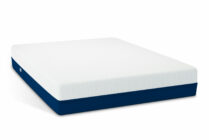Our modern-day sedentary lifestyles have us spending every day hunched over and staring at a screen for most of our waking hours. This often results in poor posture that often leads to back and neck pain, as well as persistent muscle tension. So, you might be wondering how best to reverse the damage done to our back and which mattress is right for you. In this article, we’ll compare an orthopedic mattress vs. a Posturepedic mattress so you can choose the right one for your needs.
When comparing a traditional orthopedic mattress vs. a Posturepedic mattress, both types of mattresses are designed to relieve back pain, muscle tension, and provide support to alleviate pressure-related pain in the shoulder, spine, and hip. However, Posturepedic mattresses are premium quality orthopedic mattresses that include additional cooling foam layers and encased coil springs which make it extra durable and supportive.
3 orthopedic mattresses recommended by doctors
Read on to see how orthopedic and Posturepedic mattresses can assist with providing proper support for your spine and joints which will reduce backache and other pain.
What Is An Orthopedic Mattress?
An orthopedic mattress is a mattress that is specially designed for people that cannot sleep comfortably on an ordinary mattress because of injuries, medical conditions, or back and joint pain. These injuries can be the result of an accident or due to repetitive stress – for example from sitting. This article from the Scandinavian Journal of Public Health discusses how sitting constantly while working is associated with lower back pain.
Orthopedic mattresses are designed to reduce upper or lower back pain by providing extra spinal support and a firmer sleep surface. They are typically made from memory foam, latex, or innerspring which provide greater support for the spine and reduce pressure on joints.
Typically orthopedic mattresses are made of multiple layers of the above materials and each layer has a role. Layers that are closer to the body provide more comfort (they’re softer and cooler) while layers far away from the body provide support (they’re stiffer and more durable). Additionally, some mattresses may contain grooves or creases which constrain the movement of the sleeper so they maintain proper posture. Take a look at this orthopedic mattress to see how it keeps the spine aligned with different sections that are soft, firm, and medium-firm. A mattress like this one assist in reducing pain that is usually associated with musculoskeletal issues that affect the bones, joints, ligaments, tendons, and muscles.
To find out more about how an orthopedic mattress can help to reduce pain and discomfort by correctly supporting the curved spine check out our article that discusses choosing an orthopedic mattress for scoliosis. Orthopedic mattresses can also be beneficial for people suffering from sciatica as explained in our article that provides tips to choose an orthopedic mattress for sciatica pain.
And for more generalized information, be sure to take a look at our more detailed guide explaining why orthopedic mattresses work.
What Is A Posturepedic Mattress?
Posturepedic is a combination of the two words posture and orthopedic. The Posturepedic mattress is considered to be the premium level of orthopedic mattresses, because it has been developed with the help of orthopedic surgeons, and provides proper support for the areas that need extra cushioning like the neck, spine, and hips. You’ll notice the Orthopedic Advisory Board on the Posturepedic website.
Posturepedic mattresses are designed for people who have chronic back pain or muscle tension, and who want effective support and comfort. Posturepedic mattresses have unique features like titanium innerspring coils and memory foam layers that allow for tension relief, and spine support while sleeping.
This Posturepedic mattress provides correct body-weight distribution and prevents heavier areas of the body, like the hips and shoulders, from sinking into the mattress which causes incorrect spinal curvature during sleep.
Orthopedic Mattress Vs. Posturepedic Mattress — Comparison of Materials
An orthopedic and Posturepedic mattress can both be manufactured using various materials like memory foam, latex, gel foam, and innerspring. The difference is in the specific types of these various materials used in these two types of mattresses.
Orthopedic mattresses are typically made from layered foam materials and regular innerspring technology, whereas Posturepedic mattresses consist of a base layer of titanium innerspring coils that offer more resistance, as well as layers of foam that enhance comfort levels.
Orthopedic mattresses are manufactured from memory foam layers and innerspring layers. A Posturepedic mattress, like this, is made of titanium innerspring coils that can withstand the pressure exerted by the body while providing firm support. There is also an extra layer consisting of a mixture of memory foam and gel-infused Viscoelastic foam which provides extra cushioning allowing the mattress surface to conform to the body. This article from IngentaConnect explains how viscoelastic foam assists with preventing pressure injuries and aids recovery in hospitalized patients.
You may also be interested in our tips for finding an orthopedic mattress without springs. So be sure to check that article out too. Also, our article on choosing an orthopedic mattress for hypermobility may be of interest as well.
Sealy Posturepedic Mattress Price Vs. Typical Orthopedic Mattresses
Sealy Posturepedic mattresses come with different features and various firmness levels, so you’ll notice a range of prices. Prices will also vary at various retailers since Sealy doesn’t sell these mattresses directly. In much the same way, different mattress manufacturers will offer orthopedic mattresses at different price levels.
Sealy Posturepedic mattress prices can range from $800 to $1700, and orthopedic mattress prices can range from $400 to $5000. Both orthopedic mattresses and Posturepedic mattresses are more expensive than regular mattresses.
Our orthopedic mattress price guide offers an in-depth price comparison as well as tips on choosing the right mattress for your needs.
Make sure to also read our ultimate orthopedic mattress weight guide for more information on orthopedic mattresses.
Durability of Posturepedic Mattresses Vs. Orthopedic Mattresses
When it comes to durability, both mattresses are made of high-quality materials which make them very durable and both could last from 7 to 10 years, and usually have a 10-year warranty.
Sealy Posturepedic mattresses have a 10-15 year warranty and a 1 to 2-day return policy. Typically, orthopedic mattresses have a 10-20 year warranty and a 1 to 2-day return policy.
A Comparison of the Construction of Orthopedic Mattresses Vs. Posturepedic Mattresses
Orthopedic mattresses are usually quite firm to ensure correct spinal alignment to help alleviate stress on the spine and reduce back pain—in addition to evenly distributing your body weight to prevent the build-up of pressure in various points of the body. In this article from the Journal of Applied Ergonomics, Posturepedic mattresses were compared to other top-of-the-line orthopedic mattresses. You’ll notice that all mattresses provided excellent pressure-point relief at different spine locations. To find out more we recommend reading our article about the 7 benefits of choosing an orthopedic mattress.
Posturepedic mattresses support system allows for the transfer of motion—the mattress responds to your body weight and motion by providing resistance with the strong innerspring coils—which means that the sleeper doesn’t sink into the mattress. The comfort provided by the mattress comes from the top layers which are made of a mixture of memory foam and gel-infused Viscoelastic.
Are Posturepedic Mattresses Covered by Medicare?
Medicare usually covers orthopedic mattresses which fall under the classification of durable medical equipment (DME) when prescribed by a doctor.
A Posturepedic mattress can be covered by Medicare if it is prescribed by a medical doctor and is deemed essential for a patient’s recovery, or is considered medically necessary for a particular injury or medical condition like sciatica, arthritis, or scoliosis.
Check out our article to find out whether Medicare will pay for an orthopedic mattress and how to go about claiming for one.
How To Choose The Right Mattress For You
Choosing an orthopedic mattress can seem daunting because there are so many varieties that have different firmness levels, heights, and density levels. These various factors are what make them suitable for different needs and preferences.
When choosing an orthopedic mattress it is important to consider what firmness level would be suitable, the height and density of the mattress, and what size mattress will fit on the existing bed frame or base.
To find out more about the various firmness levels of orthopedic mattresses read our article about choosing an orthopedic mattress for elderly sleepers which has useful information about the various firmness levels of these mattresses.
| Reason For Purchasing A New Mattress: | Which Is Better For You – Orthopedic Or Posturepedic Mattress? | Why Is This Mattress the Better Option? | Example |
| Better Back Support | Both mattresses | Both mattresses provide excellent support for your back. If you want a firmer mattress then choose a Posturepedic mattress. If you desire something a little softer, then an orthopedic mattress is the right choice. |
Sealy Posturepedic Foam Paterson Medium Feel Mattress, Queen ~$920 |
| More Comfort For Two Sleepers | Posturepedic Mattress | Provides more comfort, softness, and lower transfer of motion. | Sealy Posturepedic Spring Summer Rose Faux Eurotop Firm Feel Mattress, King~$1250 |
| Better Joint Pain Relief | Posturepedic Mattress (note: other premium orthopedic mattresses are also comparable) | Provides the necessary support for joints and spine, and helps to relieve muscle tension. | Novilla Queen Size Gel Memory Foam Mattress – Medium Firm Feel~$380 |
| Better for back/joints injuries | Posturepedic Mattress (note: other premium orthopedic mattresses are also comparable) | Superior support allows for proper spine alignment. This helps release all muscles and joint tension. | Swiss Ortho Sleep, 12″ Inch Contour Mattress – Queen~$360 |
Make sure to also take a look at our quick comparison between orthopedic mattresses vs latex mattresses to see what the differences might be. And, you might be interested in learning what mattresses do orthopedic doctors recommend. Be sure to read our related articles to find out more.
Key Takeaways
Understanding Orthopedic and Posturepedic Mattresses
Both orthopedic and Posturepedic mattresses aim to alleviate back pain and muscle tension by offering superior support to the spine, shoulders, and hips. However, Posturepedic mattresses, often viewed as the premium level of orthopedic mattresses, come with added features like cooling foam layers and encased coil springs, enhancing their durability and supportiveness.
Materials and Construction
Orthopedic mattresses generally comprise layers of memory foam, latex, or innerspring to provide the necessary spinal support, whereas Posturepedic mattresses incorporate a base layer of titanium innerspring coils for extra resistance along with foam layers for comfort. The construction of these mattresses is aimed at ensuring correct spinal alignment and preventing pressure build-up at different body points.
Durability and Warranty
Both mattress types are built with high-quality materials, promising a durability that spans 7 to 10 years, usually backed by a 10-year warranty. Sealy Posturepedic mattresses offer a warranty extending up to 15 years, showcasing a commitment to long-term performance and customer satisfaction.
Price Range
The price range for these mattresses varies, with Sealy Posturepedic mattresses ranging from $800 to $1700, and orthopedic mattresses ranging from $400 to $5000. The pricing reflects the level of support, comfort, and additional features provided by these mattresses, making them a worthwhile investment for individuals seeking relief from back and joint pains.
Medicare Coverage
Orthopedic mattresses are usually covered by Medicare under the classification of durable medical equipment (DME) when prescribed by a doctor. Similarly, Posturepedic mattresses may be covered if deemed essential for a patient’s recovery from specific medical conditions or injuries.
Choosing the Right Mattress
Selection between an orthopedic and a Posturepedic mattress boils down to individual needs and preferences concerning firmness, height, and density. Understanding one’s comfort preferences, the severity of back or joint pains, and the budget are crucial factors in making an informed decision to achieve better sleep quality and improved spinal health.




